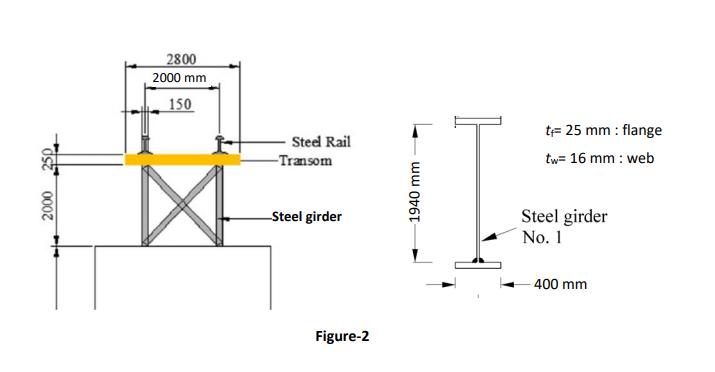Question
The cross section of a railway bridge deck is shown in Figure 2 . The bridge deck comprises of two steel girders which are 2
The cross section of a railway bridge deck is shown in Figure 2. The bridge deck comprises of two steel girders which are 2 m apart. The bridge span is 10 m and the steel girders are simply supported. The bridge deck has an approach slab and the transoms have been directly connected to the steel girders. The railway is not ballasted. The total weight of rails (a pair) and transoms is 20 kN/m. The self‐weight of rails, transoms and steel girders are the only permanent effects (PE).
‐ Determine the maximum bending moment at mid‐span of each steel girder only due to PE + railway traffic.
-Use the results of previous step to check the adequacy of flexural capacity of the steel girders. Note: Section bending moment capacity Ms and member bending moment capacity Mb both should be considered.
-Determine the maximum shear force at the support only due to PE + railway traffic.
-Use the results of previous step to check the adequacy of shear capacity of the steel girders web and determine whether any web shear stiffeners are required.
Assumptions:
‐ The steel plates are 350 grade (AS/NZS3678)
‐ Take weight per unit volume of steel 78 kN/m3.
‐ The steel girders are heavily welded.
‐ The steel girders have partial (P) lateral‐torsional restraints only provided at the end span (support) points. No lateral rotational restraint has been provided along the girders.

2800 2000 mm 150 te 25 mm : flange Steel Rail -Transom tw= 16 mm : web Steel girder Steel girder No. 1 400 mm Figure-2 dsz 0007 1940 mm
Step by Step Solution
3.52 Rating (169 Votes )
There are 3 Steps involved in it
Step: 1
Section modalus 27 1e r x 10 mn 29042 XI 1440 Beuding capacity My ty o 067 x350 X 2...
Get Instant Access to Expert-Tailored Solutions
See step-by-step solutions with expert insights and AI powered tools for academic success
Step: 2

Step: 3

Ace Your Homework with AI
Get the answers you need in no time with our AI-driven, step-by-step assistance
Get Started


